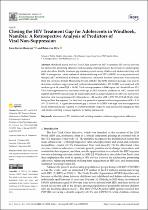| dc.contributor.author | Munyayi, Farai Kevin | |
| dc.contributor.author | van Wyk, Brian | |
| dc.date.accessioned | 2023-02-06T08:04:27Z | |
| dc.date.available | 2023-02-06T08:04:27Z | |
| dc.date.issued | 2022 | |
| dc.identifier.citation | Munyayi, F. K., & van Wyk, B. (2022). Closing the HIV treatment gap for adolescents in Windhoek, Namibia: A retrospective analysis of predictors of viral non-suppression. International Journal of Environmental Research and Public Health, 19(22), 14710. https://doi.org/10.3390/ijerph192214710 | en_US |
| dc.identifier.issn | 1660-4601 | |
| dc.identifier.uri | https://doi.org/10.3390/ijerph192214710 | |
| dc.identifier.uri | http://hdl.handle.net/10566/8351 | |
| dc.description.abstract | Windhoek joined the Fast-Track Cities Initiative in 2017 to optimize HIV service delivery
for adolescents, promoting adherence and sustaining viral suppression. Recent surveys and programmatic data show that the treatment gap remains greatest among children and adolescents living with
HIV. A retrospective cohort analysis of adolescents living with HIV (ALHIV) receiving antiretroviral
therapy (ART) at Windhoek healthcare facilities was conducted. Routine clinical data were extracted
from the electronic Patient Monitoring System (ePMS). The SPSS statistical package was used to
determine viral non-suppression and perform inferential statistics. 695 ALHIV were analysed with
median age of 16 years (IQR = 13–18). Viral non-suppression at 1000 copies/mL threshold was 12%.
Viral non-suppression was associated with age at ART initiation, duration on ART, current ART
regimen and WHO Clinical Stage. In multivariate analysis, longer duration on ART was a protective
factor for viral non-suppression (13–24 months vs. >24 months: aOR = 8.92, 95% CI 2.60–30.61), while
being on third line regimen (vs. first line) was protective against viral non-suppression (aOR = 0.11,
95% CI 0.03–0.49). A significant treatment gap is evident for ALHIV with high viral non-suppression
levels. Interventions are required to counter treatment fatigue to keep adolescents engaged in ART,
and timely switching to rescue regimens for failing adolescents. | en_US |
| dc.language.iso | en | en_US |
| dc.publisher | MDPI | en_US |
| dc.subject | Public health | en_US |
| dc.subject | HIV | en_US |
| dc.subject | Adolescents | en_US |
| dc.subject | Patient | en_US |
| dc.subject | Namibia | en_US |
| dc.title | Closing the HIV treatment gap for adolescents in Windhoek, Namibia: A retrospective analysis of predictors of viral non-suppression | en_US |
| dc.type | Article | en_US |

